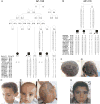A homozygous missense variant in type I keratin KRT25 causes autosomal recessive woolly hair
- PMID: 26160856
- PMCID: PMC5090258
- DOI: 10.1136/jmedgenet-2015-103255
A homozygous missense variant in type I keratin KRT25 causes autosomal recessive woolly hair
Abstract
Background: Woolly hair (WH) is a hair abnormality that is primarily characterised by tightly curled hair with abnormal growth.
Methods: In two unrelated consanguineous Pakistani families with non-syndromic autosomal recessive (AR) WH, homozygosity mapping and linkage analysis identified a locus within 17q21.1-q22, which contains the type I keratin gene cluster. A DNA sample from an affected individual from each family underwent exome sequencing.
Results: A homozygous missense variant c.950T>C (p.(Leu317Pro)) within KRT25 segregated with ARWH in both families, and has a combined maximum two-point LOD score of 7.9 at ϴ=0. The KRT25 variant is predicted to result in disruption of the second α-helical rod domain and the entire protein structure, thus possibly interfering with heterodimerisation of K25 with type II keratins within the inner root sheath (IRS) of the hair follicle and the medulla of the hair shaft.
Conclusions: Our findings implicate a novel gene involved in human hair abnormality, and are consistent with the curled, fragile hair found in mice with Krt25 mutations, and further support the role of IRS-specific type I keratins in hair follicle development and maintenance of hair texture.
Keywords: K25; KRT25; autosomal recessive woolly hair; inner root sheath; type I keratin gene cluster.
Published by the BMJ Publishing Group Limited. For permission to use (where not already granted under a licence) please go to http://group.bmj.com/group/rights-licensing/permissions.
Conflict of interest statement
Conflicts of Interest: None declared.
Figures

References
-
- McLean WHI, Moore CBT. Keratin disorders: from gene to therapy. Hum Mol Genet. 2011;20:R189–97. - PubMed
-
- Stenn KS, Paus R. Controls of hair follicle cycling. Physiol Rev. 2001;81:449–94. - PubMed
-
- Langbein L, Rogers MA, Praetzel-Wunder S, Helmke B, Schirmacher P, Schweizer J. K25 (K25irs1), K26 (K25irs2), K27 (K25irs3), and K28 (K25irs4) represent the type I inner root sheath keratins of the human hair follicle. J Invest Dermatol. 2006;26:2377–86. - PubMed
-
- Harel S, Christiano AM. Genetics of structural hair disorders. J Invest Dermatol. 2012;132:E22–6. - PubMed
Publication types
MeSH terms
Substances
Supplementary concepts
Grants and funding
LinkOut - more resources
Full Text Sources
Other Literature Sources
Medical
Molecular Biology Databases
Research Materials
